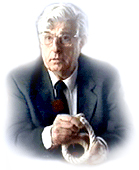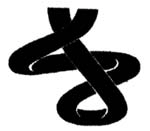
Francisco Torrent-Guasp
BIOGRAPHY

You may download this page as Adobe Acrobat PDF file (144 KB) following the link bellow.
Francisco Torrent-Guasp, was born on October the 7th, 1931 in Gandía (Valencia. Spain). He was a medical student at Salamanca and Complutensis Madrid Universities (Spain) from 1950 to 1955, where he becomes doctor on Medicine and Surgery. Working with Prof. Gómez Oliveros he starts, being a IV year student, anatomical investigations about the structure and function of the heart, that he will continue for more than 25 years, performing during this period of time, disections on more than 1000 hearts of different species, including worms, fishes, reptiles, and mammalians, including human hearts as well. His extraordinary discovery of the VENTRICULAR MYOCARDIAL BAND in 1972, conceiving the ventricular myocardium as a continuous muscular mand, was the leading cause of being laureate of Miguel Servet Prize (1978) and an official nominee for the Nobel Prize in Medicine (1978). During a half century of painstaking work on heart structure and function, he has published numerous books and papers and gave more than one hundered lectures. Some of those activities are summarized here in a chronological order:
-
1954: EL CICLO CARDIACO (THE CARDIAC CYCLE); is a monograph published while a 4th year medical student at the University of Salamanca (Spain).
-
1957: ANATOMIA FUNCIONAL DEL CORAZON (FUNCTIONAL ANATOMY OF THE HEART). Is an anatomical research on heart structure, supported by "Sociedad de Autores y Publicaciones". Madrid.
-
1959: AN EXPERIMENTAL APPROACH ON HEART DYNAMICS. A report on experimental work on heart physiology (Eugene Taldmadge Hospital. Augusta. Georgia. USA). Supported by a fellowship of The American Heart Association and The Public Health Service of the USA.
-
1960-1970: Anatomical research, publications, and lectures continued.
-
1970: THE ELECTRICAL CIRCULATION. Theoretical work published followed by a lecture at the University of Friburg (Germany), leading to a publication jointly with Prof. A. Puff, entitled; LA DINAMICA VALVULAR (VALVULAR DYNAMICS). An invited lecture at Guy's Hospital (London) was followed by four more up to 1977. A meeting with the well known surgeon Donald Ross, interested in Torrent-Guasp's proposal concerning mitral valve prothesis, at the VIth World Congress of Cardiology in London (UK), led to five invited lectures at The National Heart Hospital (London).
-
1972: Always enphasising anatomical research of the heart, and supported by "Fundación Juan March" (Spain), presented invited lectures at the Universities of Stockholm, Göteborg, Amsterdam, Leyden, Hannover, París (La Pitié), Milan (Prof. Folli), and Rome (Prof. Cortesini). Coming back to Spain he is nominated Associate Professor of Physiology at Barcelona Autonomous University, where he presented THE CARDIAC MUSCLE, a publication sponsorized trough a grant of "Fundación Juan March".
-
1973: Twenty nine invited lectures supported by "Fundación Juan March" are given in the Universities of Harvard, New York (Mount Sinai), Philadelphia, Charleston, Birmingham, St Louis, Toledo, Chicago, Denver, San Francisco, Los Angeles, San Diego, Portland, Seattle, Minneapolis (Mayo Clinic), and afterward, gave the Annual National Heart Hospital Surgical Lecture in London (UK).
-
1978: Nominated for The Nobel Prize, at the suggestion of Queen Sophia of Spain, The Science and Education Ministry of Spanish Governement, and Archiduke Andres Salvador Habsburgo-Lorena of Austria. He received the same year in Geneva (Switzerland) the "Miguel Servet Prize" for his long and meritorious scientific research line. Soon after, he travels to Japan to give a lecture in the University of Tokyo, Department of Anatomy, Prof. Yohro.
-
1980: LA ESTRUCTURA MACROSCOPICA DEL MIOCARDIO VENTRICULAR (MACROSCOPIC STRUCTURE OF VENTRICULAR MYOCARDIUM). An anatomical work collecting the major points on his anatomical research, is published in "Revista Española de Cardiología"
-
1982: Two invited lectures (Prof. Merker) at Berlin University (Germany).
-
1983: One invited lecture at Münster University (Germany) led to a a close and going collaboration with Prof Lunkenheimer with several results.
-
1985: KARDIODYNAMIK: WEGE ZUR STRUKTURGERECHTEN ANALYSE DER MYOKARDFUNKTION, a monograph published in German in collaboration with Prof. Lunkenheimer.
-
1987: ESTRUCTURA Y MECANICA DEL CORAZON (STRUCTURE AND MECHANICS OF THE HEART); a morphological and functional study, published in collaboration with Professors Lunkenheimer, Zarco, Streeter, Ceon Ramon, Fariña, and Aragoncillo. During the following eight years he alternates his heart anatomical research work with a philosophic approach on the evolution ot the living beings.
-
1993 he makes a silicone rubber mould of the heart that shows the ventricular myocardial band.
-
1995: The collaboration with Prof. Lunkenheimer, led, under the leadership of Prof. Torrent-Guasp, to the "FIRST WORKSHOP ON CARDIAC STRUCTURE AND PERFORMANCE" held in Alicante (Spain). The meeting, attended for 48 experts from all over the world, was supported by Prof J. Cosín and Dr. Sogorb, under the auspicies of The European, Spanish, and Valenciana Societies of Cardiology. Publication of a videotape containing a real disection of a heart, made and explained by Prof. Torrent-Guasp. An elastic mould of the heart, made up by Dr. Torrent-Guasp, was delivered to the assistants.
-
1996: Felowship of the European Society of Cardiology, and Gold Medal of the Spanish Society of Cardiology. He shares the President's Lecture with Prof. Ingels (Stanford University, Palo Alto. Calif. USA) about "LA BANDA MIOCARDICA VENTRICULAR" ("THE VENTRICULAR MYOCARDIAL BAND") during the XXXII Congress of the Spanish Society of Cardiology.
-
1997 an experimental work with MRI, on heart mechanics, is made being evidenced the way the heart performs its dualistic function : decrease (ejection) and decrease (suction) of blood by means of respective muscular contractions. Publication of several papers on that subject along 1977until 2002.
-
1998, more papers published and several invited lectures : Birmingham (Univ. of Alabama), Los Angeles (UCLA), San Diego (Univ. of California), Pasadena (California Institute of Technology), Congres at Quito (Ecuador), Barcelona (Hosp. Sant Pau), Madrid (Hosp. Clínico), Missoula (Montana), Boston (Thoracic Surgery Association Congress). In most of these centers he made dissections of the venbtricular myocardium to show the ventricular myocardial band.
-
1999, he becomes member of the Real Academia de Medicina de Cádiz. Lecture at the Departmemt of Cardiovascular Surgery of Prof. James Cox, University of Georgetown at Washington.
2000, invited lecture at the Centre Cardio-Thoracique (Monaco), at a course organized by the University of Harvard at the Hospital Clínico of Madrid, at a Congress in the Hayama Heart Center (Kamakura). Several papers in the journal of the Spanish Society of Cardiology and in the Journal of Thoracic and Cardiovascular Surgery (USA).
-
2001, the American Association of Thoracic Surgeons (AATS) publishes a monographic issue (Vol 13, No 4, October) in its journal SEMINARS IN THORACIC AND CARDIOVASCULAR SURGERY, on the heart structure and function contributions of Torrent-Guasp. He writes a chapter for the book, published by Willerson, HEART FAILURE, PATHOGENESIS AND TREATMENT and publishes a paper in the Journal of the Spanish Society of Cardiology “La mecánica de los segmentos descendente y ascendente de la banda miocárdica ventricular”. Invited Lecture at a congress on dilated myocardiopathy at Rome
-
2002, in Bethesda, organized by the National Institute of Health (USA), takes place a Workshop, on Torrent-Guasp contributions to heart structure and function, with the attendance of more than 30 American and European experts on that subject. Invited Lectures at Rome and at Belgrade.
-
2003, invited by Prof. Tetsuo Hadama, President of the Cardiothoracic Surgery (ISCTS) Japan Chapter, will attend, as guest speaker, to the 16th ISCTS Meeting that will be held on July 23rd to 25th in Kumamoto.
Currently, Francisco Torrent-Guasp with his associates, is working on several research projects dealing with basic scientifical and clinical applications of the Ventricular Myocardial Band concept.